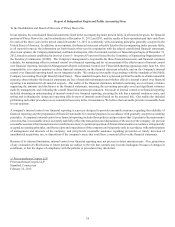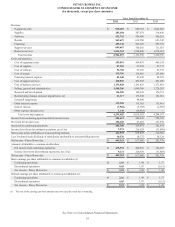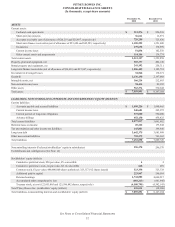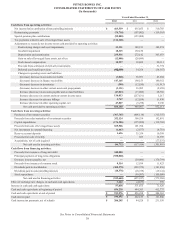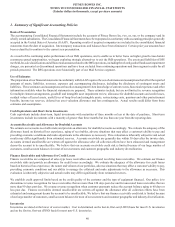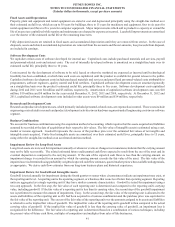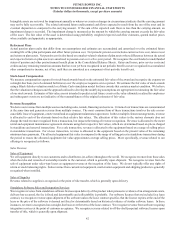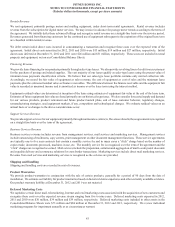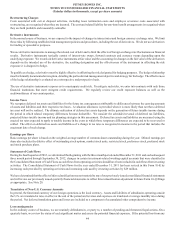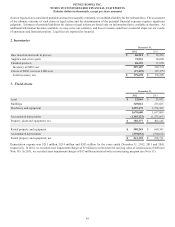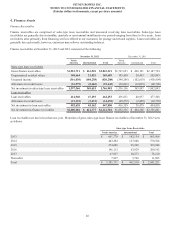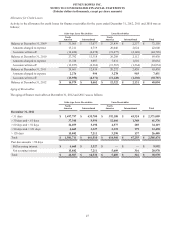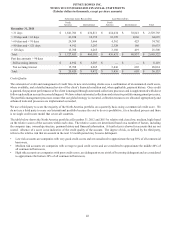Pitney Bowes 2012 Annual Report Download - page 62
Download and view the complete annual report
Please find page 62 of the 2012 Pitney Bowes annual report below. You can navigate through the pages in the report by either clicking on the pages listed below, or by using the keyword search tool below to find specific information within the annual report.PITNEY BOWES INC.
NOTES TO CONSOLIDATED FINANCIAL STATEMENTS
(Tabular dollars in thousands, except per share amounts)
44
Restructuring Charges
Costs associated with exit or disposal activities, including lease termination costs and employee severance costs associated with
restructuring, are recognized when they are incurred. The cost and related liability for one-time benefit arrangements is recognized when
they are both probable and reasonably estimable.
Derivative Instruments
In the normal course of business, we are exposed to the impact of changes in interest rates and foreign currency exchange rates. We limit
these risks by following established risk management policies and procedures, including the use of derivatives. We do not use derivatives
for trading or speculative purposes.
We use derivative instruments to manage the related cost of debt and to limit the effects of foreign exchange rate fluctuations on financial
results. Derivative instruments typically consist of interest-rate swaps, forward contracts and currency swaps depending upon the
underlying exposure. We record our derivative instruments at fair value and the accounting for changes in the fair value of the derivatives
depends on the intended use of the derivative, the resulting designation and the effectiveness of the instrument in offsetting the risk
exposure it is designed to hedge.
To qualify as a hedge, a derivative must be highly effective in offsetting the risk designated for hedging purposes. The hedge relationship
must be formally documented at inception, detailing the particular risk management objective and strategy for the hedge. The effectiveness
of the hedge relationship is evaluated on a retrospective and prospective basis.
The use of derivative instruments exposes us to counterparty credit risk. To mitigate such risks, we enter into contracts with only those
financial institutions that meet stringent credit requirements. We regularly review our credit exposure balances as well as the
creditworthiness of our counterparties.
Income Taxes
We recognize deferred tax assets and liabilities for the future tax consequences attributable to differences between the carrying amounts
of assets and liabilities and their respective tax bases. A valuation allowance is provided when it is more likely than not that a deferred
tax asset will not be realized. The ultimate realization of deferred tax assets depends on the generation of future taxable income during
the period in which related temporary differences become deductible. We consider the scheduled reversal of deferred tax liabilities,
projected future taxable income and tax planning strategies in this assessment. Deferred tax assets and liabilities are measured using the
enacted tax rates expected to apply to taxable income in the years in which those temporary differences are expected to be recovered or
settled. The effect on deferred tax assets and liabilities of a change in tax rates is recognized in income in the period that includes the
enactment date of such change.
Earnings per Share
Basic earnings per share is based on the weighted-average number of common shares outstanding during the year. Diluted earnings per
share also includes the dilutive effect of outstanding stock options, market stock units, restricted stock, preference stock, preferred stock
and stock purchase plans.
Statement of Cash Flows
During the fourth quarter of 2012, we determined that beginning with the three month period ended December 31, 2011 and each subsequent
three month period through September 30, 2012, changes in certain investment-related working capital accounts that were classified in
the Consolidated Statement of Cash Flows as cash flows from operating activities should have been included in cash flows from investing
activities. The Consolidated Statement of Cash Flows for the year ended December 31, 2011 has been revised in this Form 10-K by
increasing cash provided by operating activities and increasing cash used by investing activities by $29 million.
We have determined that the effect of this reclassification was not material to any of our previously issued consolidated financial statements
and will revise our previously issued quarterly financial statements to reflect this reclassification adjustment in future Form 10-Q filings
as appropriate. See Note 20.
Translation of Non-U.S. Currency Amounts
In general, the functional currency of our foreign operations is the local currency. Assets and liabilities of subsidiaries operating outside
the U.S. are translated at rates in effect at the end of the period and revenue and expenses are translated at average monthly rates during
the period. Net deferred translation gains and losses are included as a component of accumulated other comprehensive income.
Loss contingencies
In the ordinary course of business, we are routinely defendants in, or party to, a number of pending and threatened legal actions. On a
quarterly basis, we review the status of each significant matter and assess the potential financial exposure. If the potential loss from any


